Lady Margaret Beaufort (31 May 1443 – 29 June 1509)
Lady Margaret Beaufort was the mother of King Henry VII and grandmother of King Henry VIII.
Lady Margaret Beaufort died on the 29 June 1509 at the Abbot of Westminster’s house, only five days after the coronation of her grandson.
On the 9 July 1509, her body was buried in the south aisle of the Henry VII Lady Chapel (Westminster Abbey) in a magnificent tomb made by the Italian sculptor Pietro Torrigiano.
Erasmus composed the inscription in Latin that translates to:
“Margaret of Richmond, mother of Henry VII, grandmother of Henry VIII, who gave a salary to three monks of this convent and founded a grammar school at Wimborne, and to a preacher throughout England, and to two interpreters of Scripture, one at Oxford, the other at Cambridge, where she likewise founded two colleges, one to Christ, and the other to St John, his disciple. Died A.D.1509, III Kalends of July [29 June]”.
(Image Source: http://commons.wikimedia.org/wiki/File:Margaret_Beaufort_2.jpg)Edmund Tudor, Earl of Richmond (1430 –November 1456)
Edmund Tudor was the father of King Henry VII. During the Wars of the Roses he was captured and imprisoned in Carmarthen Castle in South Wales, where he succumbed to the plague and was buried in Carmarthen Grey Friars.
His remains where later removed to the choir of St. David’s Cathedral.
(Image Source: http://en.wikipedia.org/wiki/File:Tomb_of_Edmund_Tudor.JPG)Henry VII (28 January 1457 – 21 April 1509)
Henry VII was King of England from 22 August 1485 – 21 April 1509 and father of King Henry VIII.
He was the only son of Edmund Tudor, Earl of Richmond and Lady Margaret Beaufort.
Henry became the first king of the Tudor Dynasty after defeating Richard III at the Battle of Bosworth.
He died at Richmond Palace on the 21 April 1509 and was buried at Westminster Abbey.
Italian sculptor Pietro Torrigiano designed the magnificent tomb that Henry shares with his wife, Elizabeth of York. “The gilt bronze effigies can be seen through the fine grille which surrounds the tomb. The heads of the effigies carried at their respective funerals still survive and can be seen in the Abbey Museum, that of the king being from a death mask.” (Westminster Abbey Official Website).
The inscription on the tomb translates to:
“Here lies Henry the Seventh of that name, formerly King of England, son of Edmund, Earl of Richmond. He was created King on August 22 and immediately afterwards, on October 30, he was crowned at Westminster in the year of our Lord 1485. He died subsequently on April 21 in the 53rd year of his age. He reigned 23 years eight months, less one day.”
Around the edge of the tomb, another inscription:
“Here is situated Henry VII, the glory of all the kings who lived in his time by reason of his intellect, his riches, and the fame of his exploits, to which were added the gifts of bountiful nature, a distinguished brow, an august face, an heroic stature. Joined to him his sweet wife was very pretty, chaste and fruitful. They were parents happy in their offspring, to whom, land of England, you owe Henry VIII.”
Elizabeth of York (11 February 1466 – 11 February 1503)
Elizabeth of York was Queen consort of England from 1486 until 1503.
She was the eldest child of King Edward IV and his Queen consort, Elizabeth Woodville.
Elizabeth married Henry VII in 1486 and gave birth to their first son, Arthur, later that year.
Elizabeth died on 11 February 1503, her 37th birthday, only 9 days after giving birth to a baby girl. Sadly, her daughter only lived a few days and Elizabeth succumbed to a post-partum infection shortly thereafter.
She was buried in the Lady Chapel, Westminster Abbey in a magnificent tomb that she shares with her husband, Henry VII.
The inscription on the tomb reads:
“Here lies Queen Elizabeth, daughter of the former King Edward IV, sister of the formerly appointed King Edward V, once the wife of King Henry VII, and the renowned mother of Henry VIII. She met her day of death in the Tower of London on the 11th day of February in the year of our Lord 1502 [Old Style dating], having fulfilled the age of 37 years.”
(Image Source: http://en.wikipedia.org/wiki/File:Henry7Chapel_09.jpg)Arthur, Prince of Wales (20 September 1486 – 2 April 1502)
Arthur, Prince of Wales was the first son of Henry VII and Elizabeth of York.
He married Catherine of Aragon on 14 November 1501. Sadly, their marriage was short lived, as Arthur died suddenly at Ludlow Castle on 2 April 1502 aged only 15 years.
Arthur was buried in Worcester Cathedral where ‘Prince Arthur’s Chantry’ stands today.
Margaret, Queen of Scots (28 November 1489 – 18 October 1541)
Margaret was the elder of two surviving daughters of Henry VII and Elizabeth of York.
In 1503 Margaret married James IV, King of Scots. After James’ death in 1513, their son became James V and Margaret married Archibald Douglas, 6th Earl of Angus. Margaret’s final marriage was to Henry Stewart, 1st Lord of Methven.
Margaret died at Methven Castle on 18 October 1541 and was buried at the Carthusian Priory of St John in Perth. Unfortunately, the priory was sacked during the Scottish Protestant Revolution 1559 and fell into decay.
Henry VIII (28 June 1491 – 28 January 1547)
Henry was King of England from 21 April 1509 until his death. He was the third child of Elizabeth of York and Henry VII and the second monarch of the House of Tudor.
After a very eventful life that included six wives and the separation of the Church of England from the Roman Catholic Church, Henry died on 28 January 1547 in the Palace of Whitehall.
Henry was interred in St. George’s Chapel, Windsor Castle next to his third wife, Jane Seymour. He had planned a grand tomb for himself but unfortunately for him, it wasn’t finished in time. Instead he lies in a vault covered by a simple marble slab.
Elizabeth Tudor (2 July 1492 – 14 September 1495)
Elizabeth was the second daughter and fourth child of Henry VII and Elizabeth of York.
Elizabeth died on the 14 September 1495 and was buried in the Chapel of St. Edward the Confessor, Westminster Abbey where a small monument marks her final resting place.
She was just 3 years old.
Mary, Queen of France (18 March 1496 – 25 June 1533)
Mary was the fifth child of Henry VII and Elizabeth of York and queen consort of France through her marriage to Louis XII. After the death of Louis XII, only three months after the wedding ceremony, Mary married Charles Brandon, 1st Duke of Suffolk.
Mary’s marriage to Charles produced four children and through their eldest daughter Frances, Mary was the maternal grandmother of Lady Jane Grey.
Mary died at Westhorpe Hall, Westhorpe, Suffolk on 25 June 1533 and was buried in the abbey in Bury St Edmonds, Suffolk. The abbey was destroyed during the Dissolution of the Monasteries and Mary’s remains were moved to St. Mary’s Church in Bury St Edmunds.
Tomb of Mary Tudor, Queen of France by Sarah Morris
Edmund Tudor, Duke of Somerset (21 February 1499 – 19 June 1500)
Edmund was the sixth child of Henry VII and Elizabeth of York. Edmund was present with his elder siblings Margaret, Mary and Henry when Erasmus and Thomas More visited the royal nursery at Eltham Palace in 1499.
Edmund died on the 19 June 1500 and was buried in Westminster Abbey.

Erasmus and Thomas More visiting the children of Henry VII at Eltham Palace in 1499 and presenting Prince Henry (future Henry VIII) with a written tribute. From Left to Right: Margaret, queen consort of Scotland, aged 10, Edmund Tudor, Duke of Somerset in the arms of a nanny, Mary, Queen of France aged 3, Henry VIII, King of England then Duke of York aged 8. Absent was Arthur, Prince of Wales who was at Ludlow Castle at the time of the visit.
Catherine Tudor (or Katherine) (2 February 1503 – 10 February 1503)
Catherine was the last child of Henry VII and Elizabeth of York.
She survived only eight days and is buried along with some of her other siblings in Westminster Abbey.
Catherine of Aragon (16 December 1485 – 7 January 1536)
Catherine of Aragon was Queen consort of England as the first wife of King Henry VIII.
She was the daughter of Ferdinand II of Aragon and Isabella I of Castile and mother of Mary I.
Catherine died on 7 January 1536 (aged 50) at Kimbolton Castle, Cambridgeshire and was buried on 29 January 1536 at Peterborough Cathedral.
Read more about the death of Catherine of Aragon here.
Anne Boleyn (1501/1507 – 19 May 1536)
Read a complete fact sheet here.
Anne Boleyn was Queen of England from 1533- 1536 as the second wife of King Henry VIII.
She was the daughter of Thomas Boleyn and Elizabeth Howard and mother of Elizabeth I.
Anne was executed on Tower Green May 19 1536 and buried in an unmarked grave in the Chapel of St Peter Ad Vincula in the Tower of London.
Read more about Anne Boleyn’s burial here.
Jane Seymour (c. 1508 – 24 October 1537)
Read a complete fact sheet here.
Jane Seymour was Queen consort of England as the third wife of Henry VIII.
She was the daughter of Sir John Seymour of Wulfhall and Margery Wentworth and the mother of Edward VI.
Jane died on 24 October 1537 at Hampton Court Palace only 12 days after giving birth to Henry’s long awaited for son and heir.
On 12 November 1537 Jane was buried in St George’s Chapel, Windsor Castle. After Henry’s death in 1547 he was buried alongside Jane.
Anne of Cleves (22 September 1515 – 16 July 1557)
Read a complete fact sheet here.
Anne of Cleves was the daughter of John III, Duke of Cleves and Mary, Duchess of Julich-Berg. She was the fourth wife of King Henry VIII and Queen of England from 6 January 1540 – 9 July 1540.
Following the annulment of her marriage to King Henry VIII she was thereafter referred to as the King’s Beloved Sister.
Anne died on 16 July 1557 at Chelsea Manor, England and was buried, with great ceremony, on 3 August in Westminster Abbey near the shrine of Edward the Confessor.
Information about Anne’s final resting place from Westminster Abbey’s website:
‘She lies on the south side of the High Altar and her monument is a low stone structure of three sections with carvings showing her initials AC with a crown, lions’ heads and skulls and crossed bones (symbols of mortality). It was probably made by Theodore Haveus of Cleves but was never finished. The back part of the tomb has been mostly obscured by later monuments. The inscription on the back, visible from the south transept, reads “Anne of Cleves Queen of England. Born 1515. Died 1557? but this was not added until the 1970s.’
Catherine Howard (also spelled Katherine) Unknown – 13 February 1542
Read a complete fact sheet here.
Catherine was the daughter of Lord Edmund Howard and Joyce Culpeper. She was the fifth wife of Henry VIII and first cousin of Anne Boleyn.
Catherine was Queen consort of England from 28 July 1540 – 22 November 1541. She was found guilty of adultery and treason and executed on Tower Green on 13 February 1542.
Catherine’s remains were buried in the Chapel of St. Peter ad. Vincula at the Tower of London.
Katherine Parr (also spelled Catherine) 1512 – 5 September 1548
Read a complete fact sheet here.
Katherine was Queen consort of England and the last of the six wives of Henry VIII.
After Henry’s death in 1547, Katherine married Thomas Seymour and had a daughter, Lady Mary Seymour born August 30, 1548.
Katherine died on 5 September 1548 (aged circa 36) at Sudeley Castle, Gloucestershire and was buried in the Chapel of St. Mary at Sudeley Castle. Jane Grey was the chief mourner.
Katherine is thought to have died of puerperal fever, also called childbed fever. Coincidentally, this was also the illness that killed Katherine’s sister-in law, Jane Seymour.
Mary I of England (18 February 1516 – 17 November 1558)
Mary I was queen regnant of England and Ireland from July 1553 until her death.
She was the only surviving child of Henry VIII and Catherine of Aragon. Mary succeeded her half-brother, Edward VI, in 1553.
After Mary’s death, she was succeeded by her half-sister Elizabeth I.
Mary died aged 42 at St. James’ Palace. On 14 December, Mary was buried in Westminster Abbey in a tomb she would eventually share with Elizabeth I.
Edward VI (12 October 1537 – 6 July 1553)
Edward was King of England and Ireland from 28 January 1547 until his death.
Edward was the son of Henry VIII and Jane Seymour and the third monarch of the Tudor Dynasty.
On 6 July 1553, Edward died at Greenwich Palace aged 15. He was buried in Henry VII Lady Chapel, Westminster Abbey. His grave remained unmarked until a stone was inserted in front of the present altar. It reads:
IN MEMORY OF KING EDWARD VI BURIED IN THIS CHAPEL THIS STONE WAS PLACED HERE BY CHRIST’S HOSPITAL IN THANKSGIVING FOR THEIR FOUNDER 7 OCTOBER 1966.
Dean Stanley viewed Edward’s coffin in the 19th century and recorded the Latin inscription. Translated it reads:
“Edward the sixth by the Grace of God King of England, France and Ireland, Defender of the Faith and on earth under Christ supreme head of the churches of England and Ireland and he migrated from this life on the 6th day of July in the evening at the 8th hour in the year of our Lord 1553 and in the 7th year of his reign and in the 16th year of his age”.
Elizabeth I (7 September 1533 – 24 March 1603)
Elizabeth was the daughter of King Henry VIII and Anne Boleyn. She was Queen of England and Ireland from 17 November 1558 until her death.
Elizabeth was the fifth and last monarch of the Tudor Dynasty and reigned for 44 years.
She died on 24 March 1603 at Richmond Palace. Thousands of people turned out to see her funeral procession to Westminster Abbey on April 28 1603.
Chronicler John Stow wrote:
“Westminster was surcharged with multitudes of all sorts of people in their streets, houses, windows, leads and gutters, that came to see the obsequy, and when they beheld her statue lying upon the coffin, there was such a general sighing, groaning and weeping as the like hath not been seen or known in the memory of man.”
Elizabeth was originally buried in her grandfather’s vault (King Henry VII) in the Abbey but in 1606 was moved once her successor, King James I, completed the large white marble monument to her in the Lady Chapel.
The original wax effigy carried on her funeral hearse was remade in 1760 and it can be seen in the Abbey Museum.
The inscriptions are in Latin and translate to:
“Sacred to memory: Religion to its primitive purity restored, peace settled, money restored to its just value, domestic rebellion quelled, France relieved when involved with intestine divisions; the Netherlands supported; the Spanish Armada vanquished; Ireland almost lost by rebels, eased by routing the Spaniard; the revenues of both universities much enlarged by a Law of Provisions; and lastly, all England enriched. Elizabeth, a most prudent governor 45 years, a victorious and triumphant Queen, most strictly religious, most happy, by a calm and resigned death at her 70th year left her mortal remains, till by Christ’s Word they shall rise to immortality, to be deposited in the Church [the Abbey], by her established and lastly founded. She died the 24th of March, Anno 1602 [this is Old Style dating, now called 1603], of her reign the 45th year, of her age the 70th.
To the eternal memory of Elizabeth queen of England, France and Ireland, daughter of King Henry VIII, grand-daughter of King Henry VII, great-grand-daughter to King Edward IV. Mother of her country, a nursing-mother to religion and all liberal sciences, skilled in many languages, adorned with excellent endowments both of body and mind, and excellent for princely virtues beyond her sex. James, king of Great Britain, France and Ireland, hath devoutly and justly erected this monument to her whose virtues and kingdoms he inherits.” (Westminster Abbey Official Website)
Elizabeth shares the tomb with her half-sister Mary.
The inscription on the base of the tomb reads:
“Partners in throne and grave, here we sleep, Elizabeth and Mary, sisters, in hope of the Resurrection.”
Lady Jane Grey (1536/1537 – 12 February 1554)
Lady Jane Grey was the eldest daughter of Henry Grey and Lady Frances Brandon. Jane’s mother was the daughter of Mary Tudor, Queen of France who was Henry VIII’s sister.
Jane was proclaimed Queen after the death of Edward VI but never crowned. Her reign lasted only nine days.
Jane was executed on 12 February 1554 and buried in the Chapel of St Peter Ad Vincula, Tower of London.
Tudors buried in the Chapel of St Peter ad Vincula in the Tower of London
A plaque in the Chapel of St Peter ad Vincula in the Tower of London names those ‘Buried in this Chapel’ – among them are many Tudors. 1535 – John Fisher Bishop of Rochester Executed on Tower Hill 22 June 1535 1535 – Sir Thomas More Executed on Tower Hill 6 July 1535 1536 – […]
Thomas Boleyn’s Brass at Penshurst Church
After my initial post about ‘The Other Boleyn Boy’, that you can read here, one of my very generous readers, Gilly, offered to travel to Saint John the Baptist Penshurst to take some photos of the brass and try to uncover some more information about the other Boleyn boy – Thomas Boleyn (a sibling of […]
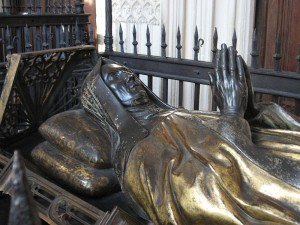

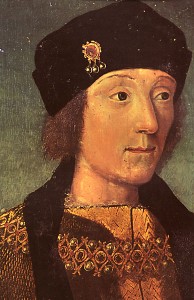
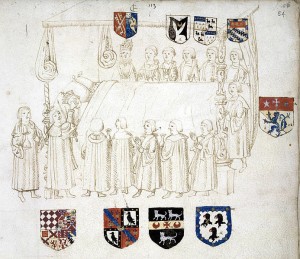

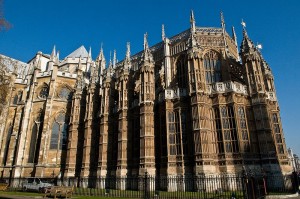

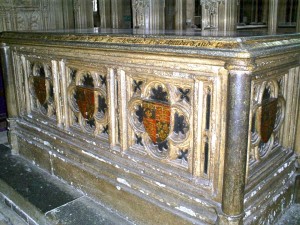

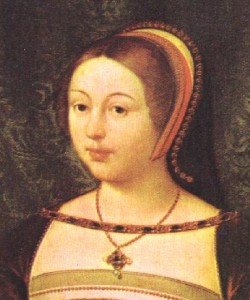
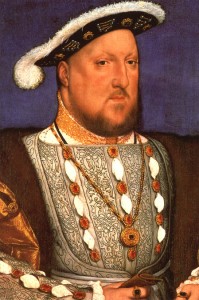
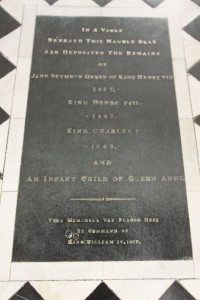
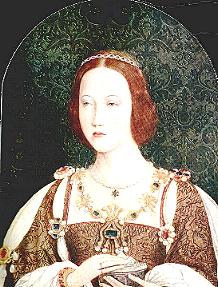
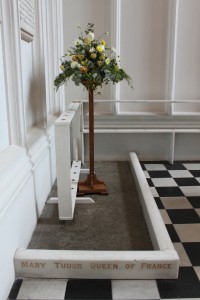


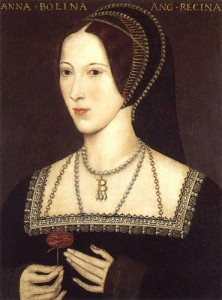

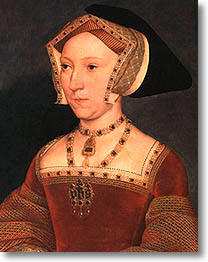
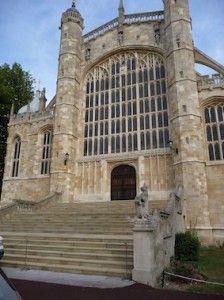
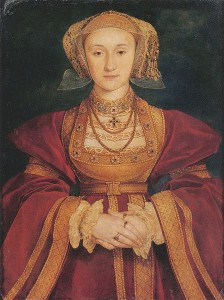
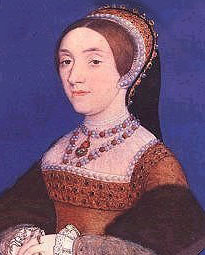
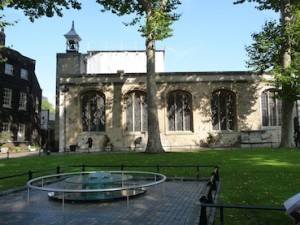
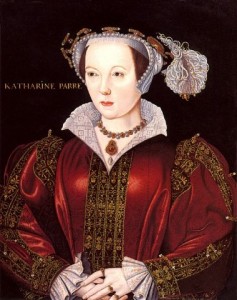

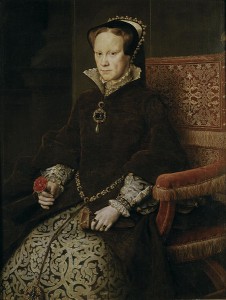
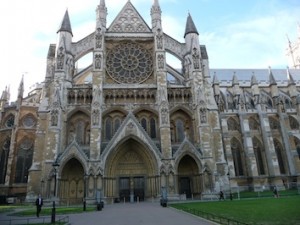

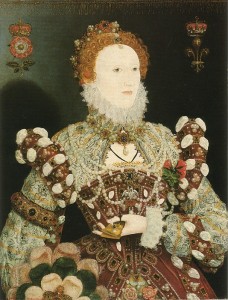
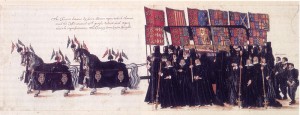
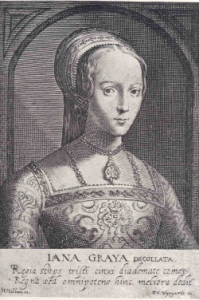

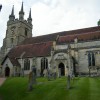















Queen Lady Margaret Tudor was my 15th Great Grandmother, I am a descendant down through Hamilton`s and Starke families. Sincerely Annette Ramsey , USA.
I have a question, I am also in relation to King Henry would you happen to have any relation to The Duke of Wellington? I am a descendant down through family and his great-great-great granddaughter.
Jessica Hornyak-Rapp, USA
Annette, are you a Ramsey through marriage or birth? It’s my last name so I’m interested in the lineage.
Jacob Ramsey
Jacob, whats your location.
My Grandad was a Ramsey in Essex/London UK
While studying my family tree I saw another tree that was, mostly and unfortunately, private but had my grandfather in it. The woman who had made the study linked us with Mary, Queen of Scots. I’m hoping to be able to continue my study. It’s very interesting. My maiden name was Hamilton.
I always wondered why Elizabeth I and Mary I were buried together. They were obviously not on the best of terms when both were alive, even though they were half-sisters. Mary even had Elizabeth sent to the Tower of London!
I read that Mary wanted to be buried next to her beloved mother, Catherine of Aragon. Did Elizabeth express her wishes concerning her burial location?
I suppose Elizabeth may have been grateful that Mary did not have her put to death…lack of a reason never stopped their father, Henry VIII, from putting troublesome people away. And Mary did not put any legal roadblocks in front of Elizabeth’s succession after Mary’s death.
I suppose ultimately it was James I’s decision to put them together for all eternity….
Thanks.
Yes I wondered that to,Thanks Annette
I also wondered about that to. They weren’t the best of sisters and shared nothing but a farther. And Mary putting Elizabeth in the tower I wouldn’t lose sleep over a lost sisterhood lol its ironic that they would be buried together and it made me raise my eyebrows. I loved this era and all the history it brought with it. Hopefully one day I hope to visit these burial sites and to be amazed by the people that changed history in a unique way.
What happened to the children born (the dead babies) to Henry VIII and Catherine of Aragon? Where are they buried?
This question is really quite astute. There does seem to be this overwhelming irony concerning the final resting place of these two queens. It does, however, have nothing to do with the final requests of these female monarchs. It was James I that moved his predecessor’s remains from the vault that she shared with her grandparents to the vault of her sister. In the early days of James I’s reign there was considerable time and money dedicated to the memorialization of his predecessors. James commissioned two monuments around the same time, one to his mother, Mary Queen of Scots and the other to Elizabeth I. Many historians have debated the motivation behind the decisions that James made regarding these monuments, but there seems to be the prevailing sentiment that James was promoting the legitimacy of his tenuous reign through the demonstrations of lineage. Sadly, the final requests of Mary and Elizabeth were largely ignored. In fact, Mary I had requested that her mother, Katherine of Aragon, be moved down from Peterborough to join her in her vault. Katherine is still, to this day, up in Peterborough. We cannot, however, attribute all of James’s memorialization efforts to rampant misogyny. James spent large amount of money on a tomb for his Mother to be place in the aisle opposite of the queen who had her beheaded. Your question touches upon ideas that historians have no real concrete answers to, as it is a tall order interpreting the mire that was the mind of James I.
I am sure Mary I would be happier in a Catholic Church or next to her mother.I am shocked that Henry v111 is in st Georges chapel ,Windsor with Jane Seymour and Charles 1 in the same vault under a plaque.For a king who changed history and became head of the church you would have thought he would have planned his funeral and resting place especially as his successor was Roman Catholic.I am sure Mary took great delight in sticking him under the floor !! .
I live in USA but was educated at Fettes College ,Edinburgh,Scotland
It was Henry VIII’s request in his will, drawn up just 2-3 days before he died,
to be placed next to Jane Seymour at Windsor. I have no idea why Charles I is there. Can anyone enlighten?
when Charles was beheaded they removed his body to stop it being further mutilated, they looked for a burial place and found an unmarked vault in the vault was a large coffin and a smaller coffin. plus a child burial. this was henry . his own grand tomb was never completed. this vault had room for another so they placed Charles here and remade the stone floor. a marble plaque was commissioned some years later and replaced the York stone slab.
Actually Henry’s successor was a Protestant (Edward VI). Because Edward died without issue, his Catholic half-sister Mary succeeded him – but Henry couldn’t have anticipated that.
Henry VIII’s successor was Edward VI, a Protestant.
After being executed at the Banqueting House, Whitehall, London, Charles I was buried in St. Georges Chapel in Windsor Castle because Oliver Cromwell, Lord Protector wanted his body to be a distance from London so that his grave would not become a site of pilgrimage for those still supporting the Royalist cause during the years of the Republic
If There Is Anyone Living In Around The UK And Northern Ireland, You Should Have Watched Six Wives With Lucy Worsley On Wednesday Evenings From 9:00PM-10:00PM but it has ended now so you can only watch it on the BBC IPlayer.
where was the baby boy born to henry 8 and katherine of aragon, and who live d2 months, buried?
Hi Kerrie, Henry, Duke of Cornwall, eldest son of Henry VIII and Katherine of Aragon was buried in Westminster Abbey, following his death on 22 February 1511.
Does anyone know why Mary I of England was buried in Westminster Abbey and not with her mother Catherine of Aragon, as she requested? Who was it down to? Elizabeth or James VI and I? It really so sad how even in death, Mary is cheated.
Someone else in Westminster Abbey whose burial wish wasn’t granted was Mary, Queen of Scots because she wanted to be buried in France; so sad.
If only it wasn’t too late to fix these misdeeds…
Had MQS been buried in France her remains would likely have been destroyed during the French Revolution.
Edward the V is not actually buried in Westminster Abbey another boy was actually buried there it says in a horrible history book the corpse is there to make people think the king is buried there but he’s not he is buried somewhere else.THIS IS REAL
Hi Izzy, do you mean Edward VI? Edward V was the eldest son of Edward IV who is believed to have died or disappeared during the reign of his uncle King Richard III.
Does Margaret Tudor queen of Scotland have a grave that can be visited.
No, she doesn’t. Margaret was buried in the Carthusian Priory of St John in Perth, which was later destroyed.
Actually the child buried in HenryVIII’s vault was not there when Charles I was deposited. That child is one of Queen Anne’s deposited there 50 odd years later.